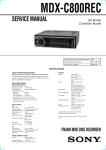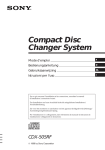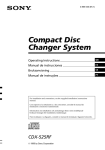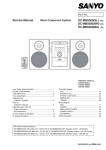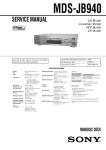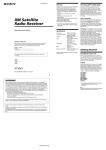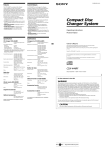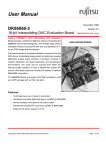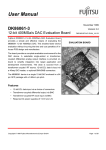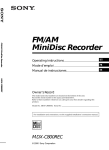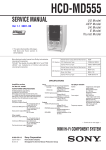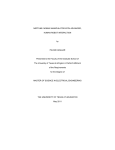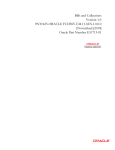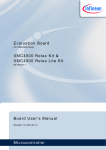Download SERVICE MANUAL - MiniDisc Community Page
Transcript
MDX-C800REC US Model Canadian Model SERVICE MANUAL SUPPLEMENT-1 File this supplement with the service manual. Subject : Electrical Adjustments 1 ELECTRICAL ADJUSTMENT TEST MODE This set has the test mode functionality. The test mode should be always set before performing adjustments. <Setting the Test Mode> 1. Input the specified voltage (14.4 V) to the ACC and BATT terminals. 2. “1:00” is displayed on the LCD display. 3. Press 4 key. 4. Press 5 key. 5. Press 1 key for more than 2 seconds. 6. All segments are lit on the LCD display entering the test mode. <Releasing the Test Mode> 1. Press OFF key. DISPLAY TEST 1. Once the test mode is set, each pressing of the DSPL key will cause the LCD display to change as follows: All segments ON Press DSPL key. Half segments ON (1) Press DSPL key. Half segments ON (2) (The other half segments that were OFF in (1) are ON.) Press DSPL key. All segments OFF Press DSPL key. TEST MODE STRUCTURE 1. Set the test mode. 2. Insert a disc and press 5 key. 3. Each time 6 key is pressed, the mode will change as follows: ADJUSTMENT mode “SHUF” indication off Press 6 key. PLAY mode “SHUF1” indication is lit. Press 6 key. REC mode “SHUF2” indication is lit. Press 6 key. Unused mode “SHUF ALL” indication is lit. Press 6 key. 2 ADJUSTMENT mode: SHUF indication off Key Description of test 2 Laser power adjustment mode 3 4 Traverse adjustment mode Focus bias adjustment mode 5 6 STOP Switch the mode ENTER DSPL CLV jitter measurement Select the display PLAY mode: SHUF1 Key Description of test 2 Laser power check mode 3 4 Focus + CLV ON Tracking servo ON/OFF 5 6 STOP Switch the mode ENTER DSPL REC mode: SHUF2 Key 2 3 4 5 6 ENTER DSPL CPLAY mode (middle/outer/inner area) Select the display Description of test Laser power check mode Focus + CLV ON Tracking servo ON/OFF STOP Switch the mode CREC mode (middle/outer/inner area) Select the display Unused mode: SHUF ALL NOTES FOR ADJUSTMENT PREPARING A CONTINUOUSLY RECORDED DISC 1. Perform the following adjustments as listed when the optical pickup and IC400, IC402 and/or IC440 in the MD SERVO board have been replaced: (1) Laser power adjustment (2) Traverse adjustment (3) Focus bias adjustment (4) CD error rate check (5) MO error rate check 2. Set the test mode to perform these adjustments. Release the test mode after the adjustments are completed. 3. Perform the adjustments in the order that they are listed. 4. Use the following jigs and measuring equipment: • Test disc (special disc for playback) TDYS-1 (Part No.: 4-963-646-01) • Laser power meter LPM-8001 (Part No.: J-2501-046-A) • Oscilloscope (Measure after the probe is calibrated.) • Digital voltmeter 5. When observing multiple signals with an oscilloscope or other equipment, take care to prevent connection between VC and ground in the oscilloscope. (Otherwise, VC and ground are shorted.) • This disc is used for focus bias adjustment and error rate check. This disc is prepared as follows: 1. Set the test mode. (See page 2.) 2. Insert a commercial disc (blank) and press 5 key. 3. Press 6 key twice to set the REC mode. (Verify that the “SHUF2” indication is lit on the LCD display.) 4. Verify that no number is displayed at the disc No. indicator. If any number is displayed, repeatedly press DSPL key until the number disappears (only two digits are displayed). 5. Press ENTER key three times and verify that there is no disc number displayed (the disc is recorded from the inner area). If “3” or “7” is displayed, press ENTER key again to clear the indicator. LCD display SHUF 2 Disc No. indicator REC mode 6. Record the data until the disc number indicator shows “9” and then press 5 key to stop recording. 7. Press Z key and take out the disc. The continuously recorded disc for focus bias adjustment and error rate check is now prepared. Note: Take care to prevent vibrations during continuous recording. 3 For the measurement points, see page 7. <Setting the read power reference value> 8. Press 2 key. LCD display LASER POWER ADJUSTMENT Connection: laser power meter optical pick-up objective lens Mode No. 0.7 mW power (LD Power Adj.) digital voltmeter MD servo board TP (I+3V) TP (IOP) + – Procedure: <Setting the write power reference value> 1. Connect a digital voltmeter between TP (I+3V) and TP (IOP). 2. Set the test mode. (See page 2.) 3. Insert a laser power meter into the disc insertion port and press 5 key. 4. Press 2 key. LCD display 9. Use DISC + or DISC – key to adjust so that the reading on the laser power meter is 0.69 to 0.71 mW. 10. Press + > M key for 2 seconds to save the data that has been set in step 9. 11. Press 2 key. LCD display Mode No. Main beam conversion power (LD Power Adj.) 12. Verify that the reading on the laser power meter is 6.0 to 6.4 mW. If outside the specified value, adjust again from step 1. 13. Press 2 key. The laser power adjustment is completed. Mode No. 7.0 mW power (LD Power Adj.) 5. Use DISC + or DISC – key to adjust so that the reading on the laser power meter is 6.9 to 7.1 mW. 6. Press + > M key for 2 seconds to save the data that has been set in step 5. 7. Verify that the digital voltmeter reads out the specified value. Specified value: Reading on the digital voltmeter: Optical pick-up label indication value ±10% (Optical pick-up label) KMS-263A 27X93 B0825 In this case, Iop = 82.5 mA Iop (mA) = Reading on the digital voltmeter (mV)/1 (Ω) 4 TRAVERSE ADJUSTMENT FOCUS BIAS ADJUSTMENT Connection: Procedure: 1. Set the test mode. (See page 2.) 2. Insert the continuously recorded disc (see page 3.) and press 5 key. 3. Press 4 key and check the error rate in the current focus bias setting. LCD display oscilloscope MD servo board TP (TE) TP (VC) + – V: 0.5 V/div H: 10 ms/div Input: DC mode Procedure: 1. Connect an oscilloscope between TP (TE) and TP (VC). 2. Set the test mode. (See page 2.) 3. Insert the test disc TDYS-1 and press 5 key. 4. Press 3 key. LCD display Mode No. Represents the Indicates the (Focus Bias Adj.) initial measurement C1 error rate <Setting the focus bias point A> 4. Verify that the first digit of the C1 error rate are “0”. Then, press 4 key. LCD display Mode No. Represents Initial set value Value after (EF-B Adj.) EF adjustment automatic adjustment 5. The traverse is automatically adjusted. Verify that the waveform of the oscilloscope meets the specified value. 6. If outside the specified value, use DISC + or DISC – to adjust the waveform. Pressing of DISC + or DISC – will cause the value after automatic adjustment to be varied. Mode No. Represent the Indicates the C1 error rate (Focus Bias Adj.) point A measurement 5. Press DISC + key until the C1 error rate value reaches “1.00” (Note 1). 6. Press + > M key for 2 seconds to save the data set in step 5. (Traverse waveform) A VC <Setting the focus bias point B> 7. Press 4 key. LCD display B Specification: A = B 7. Press + > M key for 2 seconds to save the data set in steps 5 and 6. After saving the data, verify that the initial set value is equal to the value after automatic adjustment. 8. Press 3 key. The traverse adjustment is completed. Mode No. Represents the Indicates the C1 error rate (Focus Bias Adj.) point B measurement 8. Press DISC – key until the C1 error rate value reaches “1.00” (Note 1). 9. Press + > M key for 2 seconds to save the data set in step 8. 10. Press 4 key. LCD display Mode No. Represents the Indicates the C1 error rate (Focus Bias Adj.) calculated point C measurement 5 11. Verify that the calculated point C error rate is “0.30” or less. If more than “0.30”, adjust again from step 1. 12. Press 4 key. The focus bias adjustment is completed. Note 1) Since the C1 error rate varies, the average should be read to perform this adjustment. Note 2) The relationship between C1 error rate and focus bias amount is shown in the figure below. Find out the points A and B in the above adjustment. The total focus point C is automatically calculated from the points A and B. C1 error rate 100 B MO ERROR RATE CHECK Procedure: 1. Set the test mode. (See page 2.) 2. Insert the continuously recorded disc (see page 3.) and press 5 key. 3. Press 6 key to set the PLAY mode. (Verify that the “SHUF1” indication is lit on the display.) 4. Verify that no number is displayed at the disc No. indicator. If any number is displayed, repeatedly press DSPL key until the number disappears (only two digits are displayed). 5. Press ENTER key and verify that the disc No. indicator shows “3”. If “7” is shown or there is no display, repeatedly press ENTER key until “3” is displayed. LCD display Focus bias amount A (F. BIAS) C SHUF 1 Disc No. indicator CD ERROR RATE CHECK Procedure: 1. Set the test mode. (See page 2.) 2. Insert the test disc TDYS-1 and press 5 key. 3. Press 6 key to set the PLAY mode. (Verify that the “SHUF1” indication is lit on the display.) 4. Verify that no number is displayed at the disc No. indicator. If any number is displayed, repeatedly press DSPL key until the number disappears (only two digits are displayed). 5. Press ENTER key and verify that the disc No. indicator shows “3”. If “7” is shown or there is no display, repeatedly press ENTER key until “3” is displayed. LCD display SHUF 1 Disc No. indicator PLAY mode C1 error rate 6. Verify that the C1 error rate is “0.30” or less. 7. Press 5 key. The CD error rate check is completed. 6 PLAY mode C1 error rate 6. Verify that the C1 error rate is “0.30” or less. 7. Press 5 key. The MO error rate check is completed. Measurement points: — MD SERVO BOARD (SIDE A) — I+3V IOP VC TE 7 MDX-C800REC 9-870-144-82 Sony Corporation Audio Entertainment Group 8 2000F0411-1 Printed in Japan ©2000. 6 Published by ME General Engineering Dept.








